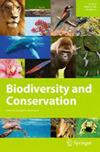中欧异质农业环境中的昆虫多样性
IF 3
2区 环境科学与生态学
Q1 BIODIVERSITY CONSERVATION
引用次数: 0
摘要
近几十年来,昆虫多样性呈显著下降趋势。造成这种负面趋势的一个主要驱动因素是农业集约化,这导致了栖息地的破坏和栖息地质量的恶化。在四年的时间里,我们在德国南部一个异质的中欧农业环境中,用28个陷阱和2个光陷阱捕获了飞行节肢动物。用虫病捕集器捕获的节肢动物,采用元条形码技术对其进行条码索引编号。利用光诱法和光塔法对鳞翅目进行了形态鉴定。在4年的研究中,共有11984个昆虫操作分类单位(otu)与BOLD (>相似度为95%)。其中昆虫目7835条,绝大多数为不同种。不同的物种丰富度估计值在8188 ~ 11,512 otu(物种代表)之间。这一数字约占德国昆虫区系总数的26-36%。光诱法捕获的鳞翅目物种多样性也很高,共捕获到502种鳞翅目(相比之下,普氏法捕获了784种)。light陷阱和Malaise陷阱的重叠率小于45%。“萎靡”陷阱捕获的昆虫表明,森林边缘的昆虫比草地中心的昆虫更多样化。我们的研究结果强调了异质农业环境对生物多样性的高价值,并且当将收集的数据与不同采样技术相结合时具有很高的价值。本文章由计算机程序翻译,如有差异,请以英文原文为准。

Insect diversity in heterogeneous agro-environments of Central Europe
Abstract Insect diversity has been decreasing significantly during the past decades. A main driver causing this negative trend is agricultural intensification, which causes habitat destruction and a deterioration of habitat quality. We caught flying arthropods with 28 Malaise traps and two light traps across a heterogeneous Central European agro-environment in southern Germany over a period of four years. The arthropods captured with Malaise traps were assigned to barcode index numbers (BINs) based on metabarcoding. Lepidopterans caught with light traps and light towers were identified based on morphological characters. Within the four years study, a total of 11,984 insect operational taxonomic units (OTUs) related to unique BINs on BOLD (> 95% similarity) were recorded across this agro-environment. 7835 of them could be assigned to insect order and the vast majority of them represent different species. Different estimates of the total species richness ranged between 8188 and 11,512 OTUs (a proxy for species). This number corresponds to about 26–36% of the total German insect fauna. Light trapping also yielded a high species diversity and returned 502 Lepidoptera species (compared to 784 species captured with Malaise traps). The overlap between light and Malaise traps was less than 45%. The Malaise trap catches showed that insects are more diverse along forest edges than in the centre of meadows. Our findings underline the high value of heterogeneous agro-environments for biodiversity, and the high value when combining data collected with different sampling techniques.
求助全文
通过发布文献求助,成功后即可免费获取论文全文。
去求助
来源期刊

Biodiversity and Conservation
环境科学-环境科学
CiteScore
6.20
自引率
5.90%
发文量
153
审稿时长
9-18 weeks
期刊介绍:
Biodiversity and Conservation is an international journal that publishes articles on all aspects of biological diversity-its description, analysis and conservation, and its controlled rational use by humankind. The scope of Biodiversity and Conservation is wide and multidisciplinary, and embraces all life-forms.
The journal presents research papers, as well as editorials, comments and research notes on biodiversity and conservation, and contributions dealing with the practicalities of conservation management, economic, social and political issues. The journal provides a forum for examining conflicts between sustainable development and human dependence on biodiversity in agriculture, environmental management and biotechnology, and encourages contributions from developing countries to promote broad global perspectives on matters of biodiversity and conservation.
 求助内容:
求助内容: 应助结果提醒方式:
应助结果提醒方式:


